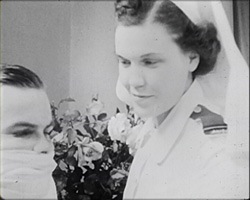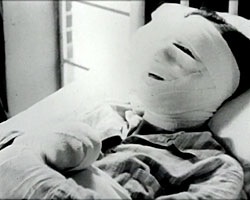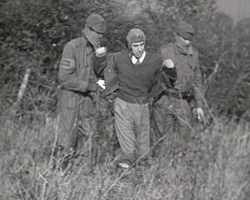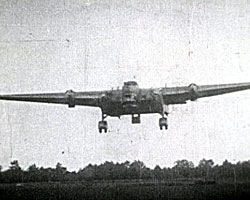Click here to print
Video of the Day: Films from the Home Front
posted April 18, 2013
 With an image of a nurse caring for a man swaddled in bandages, voiceover says: “These boys must live for a long time among us, sometimes for years.”
With an image of a nurse caring for a man swaddled in bandages, voiceover says: “These boys must live for a long time among us, sometimes for years.”
The patient is a soldier. After initial stabilization, the voice-over relates, “one of the wounded, a flier pulled from a crashed fighter plane, moves into a general ward.”
Other bandaged soldiers are around him. “They accept him with the clumsy, friendly acceptance that they had learned in cockpit and crew room.”
The film, New Faces Come Back, is in the collection of Screen Archive South East, which has offices at the University of Brighton and in Chichester, West Sussex. The 27-minute, black-and-white film is one of many films within the ambit of Films from the Home Front, a website that showcases moving images from seven regional UK screen archives and collections. The material depicts the lives of ordinary people in Britain during World War II, captured in amateur documentaries, newsreels, government films, and home movies. The material illustrates such subjects as how the home guard trained, how community and home life continued during the war, and how women’s roles changed.
The London Screen Study Collection seeks to compensate for the lack of a publicly funded regional film archive in the city. Unsurprisingly, the capital has been much filmed, so museums, libraries, archives, educational bodies, and community groups hold collections. The LSSC networks such collections to make them more accessible.
The Northern Region Film and Television Archive, founded in 1998, houses and preserves two large regional television collections dating from the late 1950s to the early 1990s. It has also acquired titles predating those collections, back to local topicals from 1912.
 It collection of films related to the Second World War is small – not surprisingly because, before television, regional film archives tended to collect amateur, industrial, and promotional film, whose production plunged during the war. Film stock and processing were difficult to obtain during the conflict; purchases of 16mm and 35 mm required official approval, and local police strictly vetted both.
It collection of films related to the Second World War is small – not surprisingly because, before television, regional film archives tended to collect amateur, industrial, and promotional film, whose production plunged during the war. Film stock and processing were difficult to obtain during the conflict; purchases of 16mm and 35 mm required official approval, and local police strictly vetted both.
The archive’s 11 WWII titles include some outstanding survivors of that process. Newcastle, from about 1940, depicts bombed houses in South Shields. Holidays at Home (1944), V.E. Day (1945), and Kendal Home Guard (ca. 1943) are even rarer because they were shot in colour.
The Media Archive for Central England serves the East and West Midlands. Its holdings reflect aspects of the region’s life during the war, such as bren-gun carriers speeding away from manufacture at Sentinel Waggon Works, official VE Day celebrations in the town, and an appeal from the mayor of Birmingham for people to join the Air Raid Precautions service in 1938.
Most of the material is the work of amateurs shooting 16mm or standard 8mm film.
 The WWII holdings of Screen Archive South East –from Surry, Sussex, and Kent – depict preparations for the war, family life during it, civil defence, and war-time and post-war community events.
The WWII holdings of Screen Archive South East –from Surry, Sussex, and Kent – depict preparations for the war, family life during it, civil defence, and war-time and post-war community events.
For example, films of the Gowlland family in Croydon, Surrey, show the introduction of ration books and black-out blinds, and family members’ commitments to the auxiliary services. Members of the Sadler family, of Sussex, sport RAF uniforms and build air-raid shelters. One keen amateur filmmaker, Ernest ‘Spot’ Botting, captured the effects of bombing raids in Kent. Other films show “land girls,” Home Guard training, and practice air-raid drills.
New Faces Come Back is among the SASE material. It depicts the pioneering plastic surgery unit known as the ‘Guinea Pig Club’ at the Queen Victoria Hospital in East Grinstead. A partially dramatised documentary, it traces the story of Jim, a flight engineer in the Royal Canadian Air Force burned badly in a plane accident who then undergoes reconstructive surgery and social rehabilitation at an East Grinstead hospital, and is then honoured by admission “Guinea Pig Club,” which had been formed by patients of a ward where surgeons were developing plastic surgery and other treatments for severe war wounds.
 The National Film Board of Canada made the film to acknowledge the work of Canadian servicemen and medical staff during the war, and to identify them as members of a British Commonwealth family working together to achieve military and medical advances. The film appeared at a time when disabled and disfigured servicemen were returning home en masse, a politically sensitive issue in countries such as Canada that were not subjected to bombings as Britain had been.
The National Film Board of Canada made the film to acknowledge the work of Canadian servicemen and medical staff during the war, and to identify them as members of a British Commonwealth family working together to achieve military and medical advances. The film appeared at a time when disabled and disfigured servicemen were returning home en masse, a politically sensitive issue in countries such as Canada that were not subjected to bombings as Britain had been.
Another Screen Archive South East holding is West Sussex Home Guard, probably made in 1941. The West Sussex Home Guard used the 20-minute training film to show recruits how to deal with various emergency situations. To that end, many scenes repeat in slow motion, while intertitles precede each scene.
The stills here are from a demonstration of how to deal with “fifth columnists.” It shows ways to properly – and improperly – carry out such tasks as discovering, disarming, and capturing dangerous interlopers on British soil.
Printed from Moving Image Archive News: http://www.movingimagearchivenews.org
URL to article: http://www.movingimagearchivenews.org/video-of-the-day-films-from-the-home-front/
Click here to print